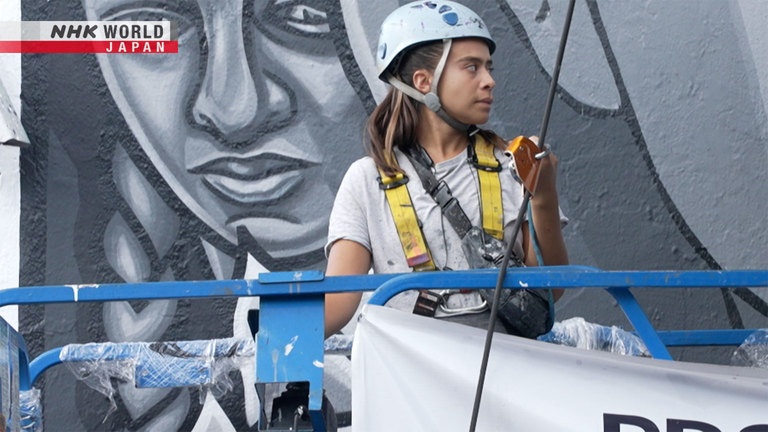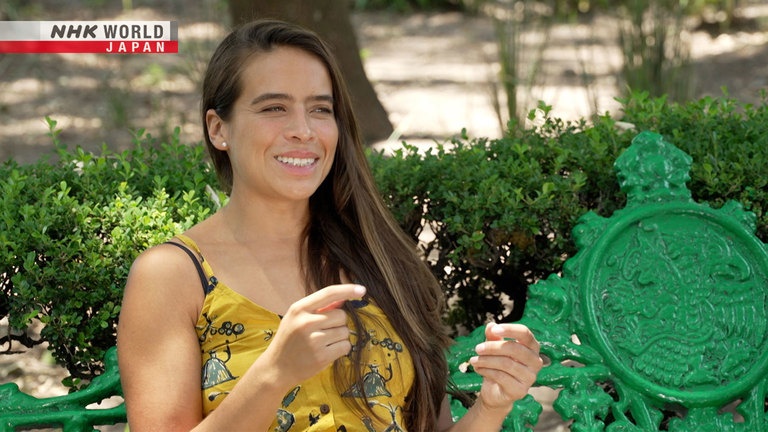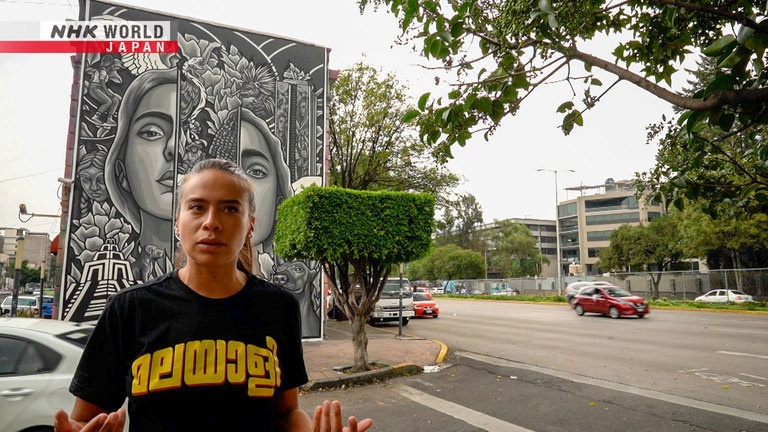Murals Break Down Walls: Paola Delfín / Muralist
Mexican muralist Paola Delfín's paintings of women and plants are imbued with peace and anti-discrimination messages. Her mural in Kyiv after the 2016 Russian invasion of Crimea drew great attention.



Transcript
Direct Talk
The walls of a building on a busy street
are her canvas.
And not only paintbrushes,
but also construction lifts and lifelines
are essential for her creative process.
She's muralist Paola Delfin from Mexico City.
The internationally active artist's motifs
include women, plants and flowers,
and her works carry a message to
a society of growing inequality and conflict.
A theme that is perhaps
repeated a lot is inequality.
And there are many issues of injustice
concerning different aspects of inequality.
Of course, there is the issue of women's
struggles, since that is something constant.
Murals Break Down Walls
In 2019,
Paola spent five months
painting a 70-meter-high mural
of two singers titled "Yolitzi",
meaning Life and Nature
in the indigenous language.
she gained attention as the heir
to the Mexican mural movement.
I use brushes.
I paint with a brush.
Brushes like these,
and rollers, but mostly brushes.
I have painted the large walls with these.
The themes of their songs are
nature and roots, ancestors.
Everything is very connected
to Mexican culture
and I chose them
as the leading roles of this mural
that talks about the climate
and about nature.
Well, they are wearing
typical Mexican costumes,
alluding to this place that once
was the largest market in Mesoamerica.
They are also surrounded by plants
from a garden that is
in the neighborhood, in Tlatelolco.
Overhead there are some quetzals that
refer to animals in danger of extinction.
It was this whole climate action theme.
Wishing for peace,
Paola painted a mural titled
"Shelter" in Kiev, Ukraine in 2016,
following the Russian invasion of Crimea.
Since then, the conflict
has turned into an all-out war,
further deepening the
significance of her message.
The message I wanted to give
was that it was a refuge.
And to remember that at the end of the day
we all come from the same place,
and that if we remember that,
we can unite and stop fighting.
And having all these unnecessary conflicts
through an image that represented peace
as something longed-for.
And for me, personally, it was meeting
a challenge of something that also scared me
and that I didn't know how to do, but
at that moment I was brave and achieved it.
It was a pretty important moment in my life.
In a place in a part of the world
that I had never visited
where the people welcomed me
with great affection
and it was a super nice place.
Now, seeing what is happening
in Ukraine at this moment,
I think that message that I tried to give
at that moment is reaffirmed.
I think now, more than ever,
that's what they need.
A girl holding a flower.
At the time, she had no actual models.
At that time it was a mix
of several images I had.
Not now, since this was in 2016.
Now I try to paint people who exist,
without mixing images.
I try to give a voice to these people
through the ones I know,
and do that kind of research.
In 2023, Paola painted several murals in India.
This one is in Delhi.
The bearded man on the left is a sculptor.
The woman next to him has been running
a store selling sweets and drinks here
for more than 15 years.
And the girl holding a dog on the right
lives with her family next to her store.
All of these are people Paola actually met.
In Delhi I also had the opportunity
to meet a lot of people, a lot of children,
natural places, markets where
there are a lot of individuals working.
And I wanted to include
several moments from Delhi.
That's why the mural's name is "Instant"
and consists of several instants
where I was able to experience
different ways of living our life.
I made this composition in a place
where there were many people talking about
the number of people there are in India
and how in Delhi,
being such a dense city,
I wanted to remind them that
they live in this city, and
everyone has the same importance.
And that everyone lives together.
In other words,
here is a marginal neighborhood,
and there is perhaps a neighborhood
where there is a different cast.
And yes, these social contrasts exist.
But I want you to remember that
this is just an idea
that we form in our heads.
And in Chennai I came across this canvas
that seemed incredible when I saw it.
Those giant buildings in front of a beach
where there is a fish market.
Also, I found a new culture,
a new language in this spectacular place,
which is possibly the second
longest beach in the world.
At this beach, the people in this market
live like in a small city,
in this place, in the Chennai marina,
where this market is.
It has been there for many years
and they try to ensure that their market
can remain there for more years,
since there is an issue of relocation
they're fighting to prevent
that from happening.
It's a community in struggle
and that seemed very, very, shocking to me
and at the same time very beautiful.
To see how the entire community
comes together to make their voice heard
so that they can remain in the space
where their families have grown up,
and they have lived like this for decades.
And I could see such great beauty
in a small, but huge place.
It reminds me of the way we can see things
through the perspective that we choose,
because it is a small place, but it is
also a giant in the diversity it has
and all the moments, all the differences
that I could find in the same place.
So I wanted them to be able to see
the beauty that they gave me,
and that they could see it every day,
so that they would remember
how beautiful the place where they live is,
how important the work they do is,
and that their struggle is worth it.
In other words,
that struggle for which perhaps they may
sometimes feel tired is worth it,
and that it is worth it that the place
will continue there forever, if possible.
Back in Mexico City from India,
Paola is working on a new mural inspired by
the spirit of her hometown, Mexico City.
She says she has many
important processes to go through
before actually starting to work on the wall.
Obviously, the first process
is to think about the topic.
Having chosen the theme,
I have to look for the characters
and elements to capture in the mural,
and take photos.
I do the digital sketch and composition.
Here I make a grid, a giant guide in lines
and references for myself.
With a photo, I make my drawing on top of it,
I superimpose it, and with that photo
I go up and make the drawing.
Then I move on to the process of refilling:
I mean, going up and down every hour
to see what I'm doing.
Paola was born in 1989 in Mexico City,
the capital of Mexico.
I was always drawing.
All the time that has passed,
until today, I have been painting.
After finishing school,
she started working as an illustrator.
She painted her first mural in 2012.
Encouraged by the director of the Toy Museum,
she painted a mural
with the motif of a broken doll.
I had no idea how to paint it.
It was really a super experiment.
But, I liked the fact that
I had a bigger canvas
and was exposed to more people
around my work.
At first, she primarily pursued
movement and color in her murals.
I was experimenting with a series
that talked about movement,
literally physical movement,
the movement of images.
And I wanted to bring that to the murals
simply through the state in which
the elements that speak in my work...
well, they are the human figures.
And I chose the female figure, unconsciously,
because, in the end, I am a woman.
For me, that is like the image that represents
in a more natural way what I carry inside.
I realized the context in which I live
and not only in Mexico,
but in the whole world,
because I believe that
it is important to give women a voice,
for which we have been fighting
for many years.
At first she pursued color,
but later changed to a monochromatic style.
Why was that?
The reason was simply that
I got tired of using colors,
of using the same technique always.
I got tired.
There was a time when I needed to change
and I thought it would be interesting
to do black and white illustrations,
like the ones I did when I was a child.
Because I started drawing
with black ink pens,
and I thought it was interesting to capture
in a mural what I did when I was a child.
I also found it curious because,
since I am Mexican,
in the places where I was going to paint,
many people expected me
to use a lot of colors.
Maybe there's this stereotype where,
being from a certain place,
you do things a certain way.
And I found it interesting,
because it really shouldn't be like that.
We don't have to always use
a stereotype in what we do.
Another factor that
I found interesting was that
many people also had a prejudice
against the lack of colors.
Apparently, they thought that
not painting with colors
was going to make the project sad
or have something negative.
I found it interesting to be able to
encourage people to change their minds.
Because when I finished the job,
many of the people who perhaps
at first were a little scared,
or who thought it wasn't going to look good,
changed their opinion and liked it.
For me, it was an experiment in which
I showed that things can be different.
Because different is also beautiful
and there is no single stereotype of beauty.
Another reason Paola got into murals was that
Mexico has a tradition of mural painting.
The Mexican mural movement,
which began about 100 years ago,
changed not only the Mexican art world
but also society as a whole.
The muralists dealt with many themes.
At that time the revolution had just ended
and they touched on social issues
that were taboo, and still are:
social differences , inequality...
They spoke bravely
about many political issues
and touched on them
in a perhaps controversial way,
but using spectacular techniques.
And they risked doing works that took years,
but that still exists today.
It gives me chills to see them,
because you feel that struggle
in society at that time,
and I can still see a lot of that reality now.
But I know that there were changes:
the simple change of trying to talk about
what you couldn't talk about before.
And to risk yourself
as an individual and as an artist
against any judgment
that could exist for talking about it.
I think that by having
this opportunity to create,
we must also have the courage
to be able to address topics
that may be taboo,
but that need to be spoken.
Seeing artists who did it, it encourages me
to have the audacity to do it too.
Finally we asked Paola for her motto.
"May art serve as a tool to heal
and transform what surrounds us."
Because I believe that for me art has served
precisely to heal and transform my life.
So I hope it can have the same effect
on the people who make art,
as well as those who see and experience it.